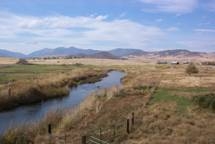"The irrigation withdrawals are very clearly what is causing the extremely low flows on both rivers," the article quoted Scott Harding, executive director of Klamath Riverkeeper, a nonprofit watchdog group aimed at restoring the river and its tributaries.
Reporter Dylan Darling turned to UC Cooperative Extension advisors Steve Orloff and Dan Drake for comment on agricultural production in the Shasta and Scott river valleys.
Orloff told the reporter that the high-elevation valleys' short growing season places farmers' focus on producing alfalfa, pasture and small grains. Drake said most of the crops are grown to feed cattle. In the two valleys, there are about 40,000 head of cattle combined.
Erica Terence, a spokeswoman for Klamath Riverkeeper, told the reporter she doesn't want to wait for a dramatic fish kill to prompt changes to water use in the valleys.
"I don't think that means the end of farming," Terence was quoted. "I think that means that farming will look different."
Jim Morris, president of the Siskiyou County Farm Bureau and a member of a family with a 200-year farming history in the area, acknowledged that the river goes dry in years of light rain and snowfall.
"It is a natural process and it just happens," Morris was quoted.
Local farmers and ranchers, he said, have taken steps to improve the efficiency of their irrigation systems - such as shifting from flood irrigation to sprinkler systems.
"We'd like to be around for another 200 years," Morris said.
Attached Images:
